- Home
- D. H. Lawrence
Sons and Lovers (Barnes & Noble Classics Series) Page 2
Sons and Lovers (Barnes & Noble Classics Series) Read online
Page 2
Since Freud, mother love versus romantic love has become a familiar theme. Hundreds of pages, perhaps thousands, have been written about Lawrence’s Oedipus complex as demonstrated in the novel. Critics began to see the novel in a Freudian light as early as 1913; Sons and Lovers was taken to be the first, great, Freudian allegory. “As he stooped to kiss his mother, she threw her arms round his neck, hid her face on his shoulder, and cried, in a whimpering voice, so unlike her own that he writhed in agony,” Lawrence wrote. “‘And I’ve never—you know, Paul—I’ve never had a husband—not really—’ ” Mrs. Morel says. Paul “stroked his mother’s hair, and his mouth was on her throat” (page 234).
Although Lawrence was aware of Freudian ideas as early as 1912, there is no indication that he intended the book to have a Freudian subtext. Responding to the Freudian interpretation, he thought the critics had carved a half lie from an honest portrayal of his childhood. He saw what he had written as a novel, not a case history, and considered the text universal, a representation of “the tragedy of thousands of young men in England” (from the Garnett letter of November 1912). Later, in 1921, he published an anti-Freudian tract titled Psychoanalysis and the Unconscious.
However, Lawrence admitted in various letters that he had loved his mother like a lover. He wrote descriptions of Mrs. Lawrence as if he were writing about a girlfriend: “She is my first, great love. She was a wonderful, rare woman—you do not know; as strong, and steadfast, and generous as the sun. She could be as swift as a white whiplash, and as kind and gentle as warm rain, and as steadfast as the irreducible earth beneath us,” he wrote to Louise Burrows in December 1910, on the eve of his mother’s death (Letters). In the same month he wrote to Rachel Ann and Taylor, “This has been a kind of bond between me and my mother. We have loved each other, almost with a husband and wife love, as well as filial and maternal.” Later in the same letter he wrote, “Nobody can have the soul of me. My mother has had it, and nobody can have it again. Nobody can come into my very self again, and breath me like an atmosphere” (Letters).
This, then, is the setting for the composition of Sons and Lovers. A remarkably gifted young man, tragically stifled under both the yoke of his mother’s love and the weight of Victorian morals, conceives of an autobiographical novel that will stick to the facts of his upbringing. Eastwood, the rundown though respectable mining town where Lawrence was born, changes to Bestwood. Lydia Lawrence, his mother, changes to Gertrude Morel. And Lawrence, with little change, renames himself Paul.
Lawrence based the character Miriam on Jessie Chambers, the doe-eyed, spiritual girl with whom he developed a friendship to rival any in fiction. “When we were alone together we were in a world apart, where feeling and thought were intense, and we seemed to touch a reality that was beyond the ordinary workaday world,” Chambers writes in her book (Chambers, p. 58). As in the novel, Chambers lived with her family on a farm a few miles away from the town. Lawrence, a year her senior, first came to the farm with his mother. Their relationship progressed in much the same way as Paul and Miriam’s. Lawrence frequently visited the farm, spending all day with the family, playing with the brothers, talking with the mother and father. When not at the farm, Lawrence wrote letters; at first he addressed them to the whole Chambers family, then gradually he addressed them only to Jessie. Their relationship developed slowly. Before they knew it, their lives were intertwined.
Lawrence left school at sixteen and took a job at a Nottingham company that manufactured medical supplies. After a brush with pneumonia and a long convalescence, he quit the job and started to work as a student teacher. He read everything he could get his hands on and, with Chambers at his side, explored the halls of the Eastwood library. The pair would leave the library literally burdened with books, their pockets stuffed with them. Ford Madox Ford once said that Lawrence was the only man he knew who read everything he claimed to have read. Chambers read alongside him. Books became their common ground.
They subjected their reading list to intense scrutiny, discussing the characters during long walks, trying to understand how a novel is constructed. Lawrence was not in the least academic in his approach. He personalized his reading, placing himself within the context of the fiction, trying on various philosophies and approaches as if they were shirts. He began to talk definitely of becoming a writer and, scribbling on scraps of paper wherever he could find them, undertook the task of becoming a poet.
Chambers was, in many ways, Lawrence’s first literary agent. In 1909, after Lawrence became frustrated at some initial rejection slips and declared he would never send off his work again, Chambers submitted three of his poems to The English Review with a letter to the editor, Ford Madox Hueffer (later Ford), expressing her admiration for the poems and for the poet. Hueffer was impressed with the poems and offered to publish them. He also wanted to meet the poet, fancying himself a great discoverer of upcoming literary talent, and invited Lawrence to his house in London. It was through Hueffer that Lawrence met Edward Garnett, a man who would champion his writing in London literary circles and fortify his heart during difficult emotional times. Lawrence wrote in a letter to his friend Ernest Collings dated November 1912 that Hueffer “discovered I was a genius—don’t be alarmed, Hueffer would discover anything if he wanted to—” (Letters). But in reality it was Chambers who first recognized Lawrence’s literary talents and who first encouraged him to write what “he was urged to ... from within” (Chambers, p. 89).
Lawrence tried his hand at writing prose. “The usual plan is to take two couples and develop their relationships,” he said on a walk with Chambers. “Most of George Eliot’s are on that plan. Anyhow, I don’t want a plot, I should be bored with it. I shall try two couples for a start” (Chambers, p. 103). Lawrence wrote The White Peacock on that plan, creating two couples and exploring their relationship. He sent Chambers pages of the manuscript as he wrote them and she, in turn, offered her criticisms. So intense was their collaboration that, upon the publication of The White Peacock in 1911, Lawrence wrote Chambers, “I its creator, you its nurse.”
The pair mostly avoided the topic of romance and sex, although gradually, as they grew through adolescence and into maturity, the issue asserted itself. Lawrence had girlfriends outside of their relationship, even going so far as to propose to one while on a train, but Chambers always occupied a primary position in his heart. “It’s like this,” Lawrence told Chambers, “some strands of your nature are knitted with some strands of mine, and we cannot be parted” (Chambers, p. 141). Later he told the girl that she was necessary to him, the “anvil on which I have hammered myself out....” (Chambers, p. 152).
Despite, or perhaps because of, the obvious mental, emotional, and spiritual connection between the two, Lawrence’s mother disapproved of Chambers. Her antipathy created an atmosphere so charged (Chambers described it as “strung-up” and “tight”) that the girl grew to dislike visiting the Lawrence home. Though Lawrence and Chambers avoided the topic of romance and sex, the issue asserted itself Mrs. Lawrence forced the question upon her son, and Lawrence, bringing the moment to its crisis, talked to Chambers. He told her that he could not bring himself to love her as “a man should love a wife” because, as he explained, between mother love and romantic love, the blood tie was the stronger of the two. “I can’t make myself love you, can I?” he cruelly asked Chambers. “I can’t plant a little love-tree in my heart” (Chambers, p. 141). The situation, as Chambers described it, was simply that while loving his mother with an almost romantic passion, he had nothing left to give a lover. “They tore me from you, the love of my life,” Lawrence remorsefully wrote to Chambers in a letter from March 1911. “It was the slaughter of the fetus in the womb” (Letters).
Mrs. Lawrence grew fatally ill with cancer during the fall and winter of 1910 as Lawrence’s first novel went into its final proofing stage. She died before she saw the novel in print. Lost in the world without his mother, Lawrence passed into a period of hopelessness and despair. Her
death, he wrote, had taken from him all his spontaneous capacity for joy. “The only antidote is work,” he wrote in a letter to his sister in March 1911. “Heaven’s—how I do but slog. It gets the days over, at any rate” (Letters).
Lawrence was not content with his first book. “Publishers take no notice of a first novel. They know that nearly anybody can write one novel, if he can write at all, because it’s about himself. A second novel’s a step further.” The Trespasser, his second novel, was published in 1912. “It’s the third that counts, though.... If [a novelist] can get over that ass’s bridge he’s a writer, he can go on” (Chambers, p. 189).
Lawrence conceived of Sons and Lovers, originally titled “Paul Morel,” during his mother’s sickness. With her death, he began working at it with a vengeance. He had mixed feelings about it and the progress he was making. “I am afraid it will be a terrible novel,” he wrote to Louise Burrows in March 1911. “But if I can keep it to my idea and feeling, it will be a great one” (Letters). In a different letter from the same month, he wrote Helen Corke, “Glory you should see [my novel]. The British public will stone me if ever it catches sight” (Letters).
Chambers and Lawrence had little contact during this time. She felt, however, that the writing of this third novel would allow Lawrence to work out his conflicting impulses, his loyalty to his mother on one side and his desire for romantic love on the other. She hoped that, through the expurgating process of writing, he could break the stifling maternal bond. She encouraged Lawrence to finish his book, hoping that, once free, he would finally be able to turn his romantic love to her.
So Lawrence wrote and Chambers waited. But as the pages of the manuscript came to her, she was horribly disappointed. “The shock of Sons and Lovers gave the death-blow to our friendship,” Chambers wrote (p. 202). The break came in the treatment of Miriam. Far from allowing Lawrence to see his way out of the painful double bind, the novel, as Chambers interpreted it, handed the laurels of victory to his mother. “He had to present a distorted picture of our association so that the martyr’s halo might sit becomingly on his mother’s brow,” Chambers wrote (p. 203). Chambers, disappointed and horrified, offered Lawrence few criticisms and broke off all but the most necessary contact.
Lawrence, who once wrote that he was incapable of standing in the world without a woman beside him, soon found Frieda Weekley, a woman he described as earthy, elemental, and passionate. She was older than he; she was married to his professor; she had three children. Even so, Lawrence convinced Frieda to run away with him to Germany after only a six-week courtship. Penniless and living in proverbial sin, the pair later moved to Italy, where, in the spring of 1913, Lawrence finished the final draft of Sons and Lovers.
Lawrence wrote Chambers the following brief letter from Italy in March 1913:I’m sending you the proofs of the novel, I think you ought to see it before it’s published. I heard from Ada that you were in digs again. Send the novel on to her when you’ve done with it.... This last year hasn’t been all roses for me. I’ve had my ups and downs out here with Frieda. But we mean to marry as soon as the divorce is through.... Frieda and I discuss you endlessly. We should like you to come out to us sometime, if you would care to. But we are leaving here in about a week, it’s getting too hot for us, I mean the weather, not the place. I must leave off now, they’re waiting for me (Letters).
Chambers, who felt she had been horribly mistreated and deceived both in fiction and in life, didn’t read the proofs of the novel. One reading was enough to last her a lifetime, she said. She sent the letter back to Italy without reply. Lawrence, at first hurt by the snub, didn’t attempt further communication. After more than ten years of love and friendship, this letter was the pair’s last contact.
Lawrence returned to England with Frieda in 1914. Her divorce finally came through and they wed. Though their relationship was often tumultuous, the marriage lasted until 1930 when, suffering from a tubercular hemorrhage, Lawrence died at the age of forty-four.
If Sons and Lovers did not bring the fortune Lawrence had hoped for, it did put him on the literary map. After 1913 the English reading public, his admirers and his critics alike, knew Lawrence was a writer to be reckoned with. They treated him accordingly. He attracted the esteem of F. R. Leavis, an influential and bombastic literary critic, who said that Lawrence was “the great creative genius of our age, and one of the greatest figures in English Literature” (The Achievement of D. H. Lawrence, edited by Frederick J. Hoffman and Henry T. Moore, p. 95). At the same time, he sparked an emotion near hatred from T. S. Eliot, who said Lawrence had a “lack of critical faculties which education should give, and an incapacity for what is ordinarily called thinking,” a sentiment that was echoed by some of the members of the bohemian Bloomsbury Group (Achievement, p. 98).
“I think, do you know, I have inside me a sort of answer to the want of today: to the real, deep want of the English people, not just what they fancy they want,” Lawrence wrote in a letter to Ernest Collings in January 1913 (Letters). “Gradually, I shall get my hold on them.” In quick succession, Lawrence wrote a collection of short stories, The Prussian Officer, and two novels, The Rainbow and Women in Love. By the time Women in Love was published, in 1921, Lawrence had indeed gotten his hooks into the English public. Unlike so many other Nottinghamshire youths who were destined for the pit, Lawrence, it became clear, was destined for the canon.
At the same time in literary history, James Joyce had published his Dubliners and was hard at work on Ulysses, Virginia Woolf was developing her “tunneling” technique through The Voyage Out, T. S. Eliot had just conceived of The Wasteland and moved to England, Old Man Yeats was developing into his last spiritual phase and had just published Responsibilities and Other Poems, E. M. Forster had exhausted his first burst of creativity, Evelyn Waugh was gathering material for his Brideshead Revisited, and Ezra Pound, who had published five collections of poems, was busy being influential. Ford Madox Ford undertook the task of discovering Modernism and was collaborating with Joseph Conrad, who had given up the sea in favor of the pen, on his later novels. British Modernism, then, was just getting underway.
The beginning of Modernism is generally marked by the imprisonment and death of Oscar Wilde and the publication of Conrad’s Heart of Darkness and its end by the death of Virginia Woolf in 1941 and the conclusion of World War II. The movement is categorized by a loosening of the constraints of plot and characterization as well as the development of a more emotive language. It is sometimes said that Lawrence is matched only by Joyce in pulling the novel into the twentieth century, though a case can be made in support of some of their other contemporaries.
Sons and Lovers is not generally considered to be Lawrence’s best book, nor his most refined. It was, however, the most widely read of his novels, and though Lady Chatterley’s Lover gave him a certain degree of infamy, Sons and Lovers is perhaps the novel for which he is most famous. In addition, it has the distinction of marking the end of his youthful period. It is Lawrence’s birthing book, so to speak. In it, he ended his literary apprenticeship and wrote himself into his mature style. A careful reader can watch the shift as it happens. Like a pregnant woman in a maternity dress, Sons and Lovers is, in reality, two books under one jacket, the old and the new together.
The book opens with a description of the Morel family in the tradition of the social realism of Dickens, Hardy, or Fielding. Here is Mrs. Morel, spitting on the iron, going off to church. Here is Mr. Morel, making gunpowder tubes for the mine, humming as he works. Children come tumbling in, tearing collars and destroying dolls. But the characters are more than types: the abused wife, the drunk husband, a flock of browbeaten children. Although the reader decides relatively early on that Morel is a scoundrel and a rogue, Lawrence, with remarkable objectivity, presents the other side of Morel. To balance the cad, we see the man bringing his wife tea in bed and wanting a kiss. Lawrence treats these scenes tenderly, endowing them with emotion while managing to avoid sentimentality
.
Part One describes all aspects of lower-class life: the births, the deaths and marriages, the holidays and fairs, the courting rituals and wooing practices, the trouble with money, the trouble with health, the fear of injury, the aspirations for social advance. Part One is simple and straightforward; it progresses along at a good clip and follows a realistic timeline. It is simple but not dull, realistic but not storybookish. It is, in short, a triumph of Victorian social realism.
Part One closes with William’s death and Paul’s illness. As Paul recovers, during the interlude between the two sections, he is reborn as a man, capable if not ready for romantic love, in a fresh relationship with his mother. Part Two opens. Miriam appears in the doorway at Willey Farm, “sixteen and very beautiful.” With the characters already firmly in place, Lawrence starts writing the novel that he was born to write.
It could be coincidence, or it could be that Lawrence had discovered his subject, but in any event it is not without note that all of the romantic and sexual scenes in the novel occur in Part Two. These scenes allowed Lawrence to write in a language that was, for him, most natural. This is the language that would later be called Lawrencian, a language elusive and vague, but yet so true. “Miriam turned to him. He answered. They were together.... Her soul expanded into prayer beside him. He felt the strange fascination of shadowy religious places. All his latent mysticism quivered into life. She was drawn to him. He was a prayer along with her” (page 185).
But then, too, there is Lawrence’s other language, the language of symbol. “Paul and Miriam walked in silence. Suddenly he started. The whole of his blood seemed to burst into flame, and he could scarcely breathe. An enormous orange moon was staring at them from the rim of the sandhills. He stood still, looking at it” (page 197). This language pervades the book: Paul tossing cherries at Miriam; the memorable scene in which Mrs. Morel holds her unnamed infant up to the setting sun. This language predicts the excursions Lawrence made into the sublime with The Rainbow and Women in Love.

 Look! We Have Come Through!
Look! We Have Come Through!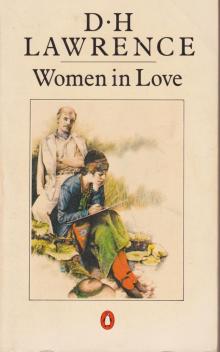 Women in Love
Women in Love The Ladybird
The Ladybird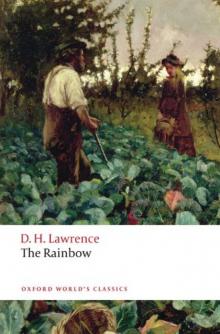 The Rainbow
The Rainbow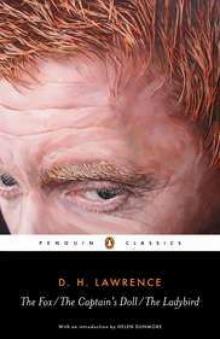 The Captain's Dol
The Captain's Dol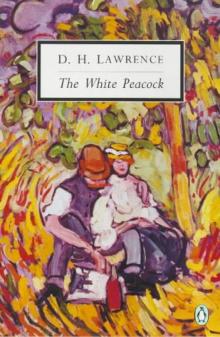 The White Peacock
The White Peacock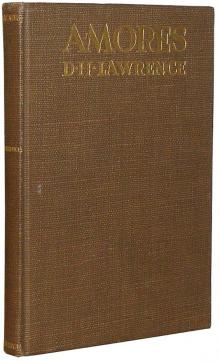 Amores
Amores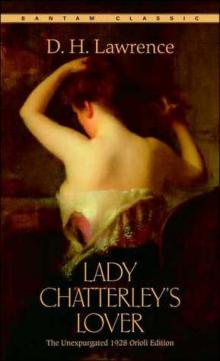 Lady Chatterley's Lover
Lady Chatterley's Lover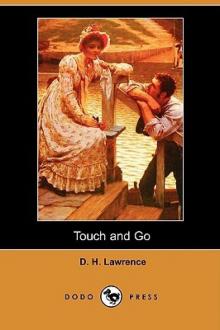 Touch and Go
Touch and Go The Wintry Peacock
The Wintry Peacock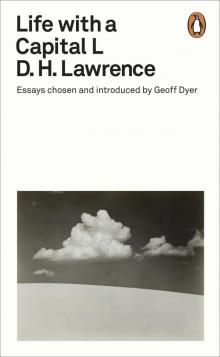 Life with a Capital L
Life with a Capital L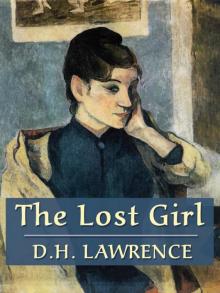 The Lost Girl
The Lost Girl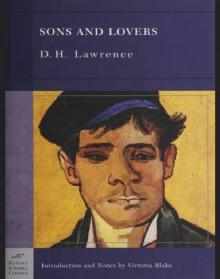 Sons and Lovers
Sons and Lovers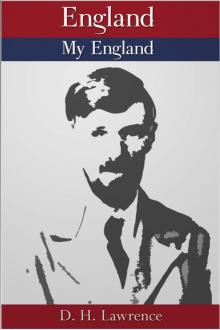 England, My England
England, My England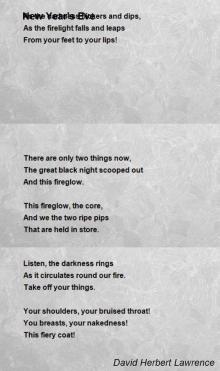 New Poems
New Poems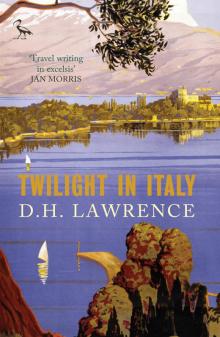 Twilight in Italy
Twilight in Italy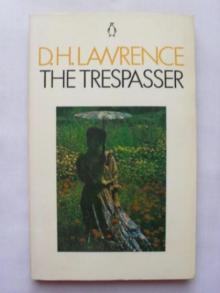 The Trespasser
The Trespasser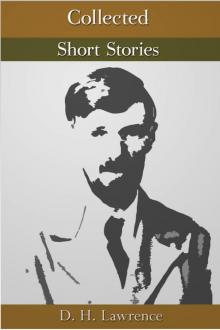 The Collected Short Stories
The Collected Short Stories The First Lady Chatterley's Lover
The First Lady Chatterley's Lover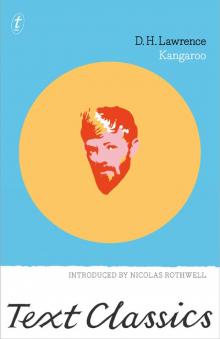 Kangaroo
Kangaroo Bay
Bay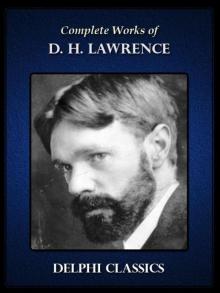 Complete Works of D.H. Lawrence
Complete Works of D.H. Lawrence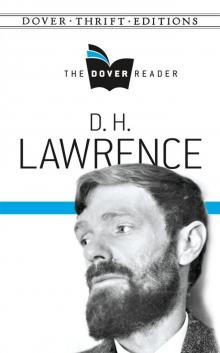 D H Lawrence- The Dover Reader
D H Lawrence- The Dover Reader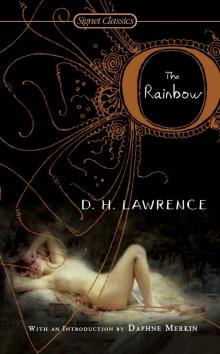 The Rainbow (100th Anniversary ed.)
The Rainbow (100th Anniversary ed.)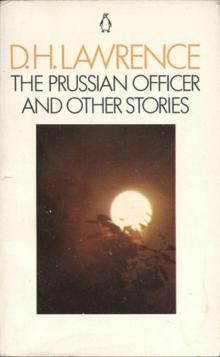 The Prussian Officer
The Prussian Officer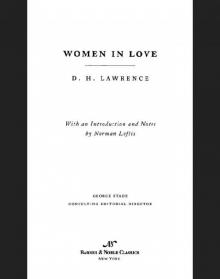 Women in Love (Barnes & Noble Classics Series)
Women in Love (Barnes & Noble Classics Series)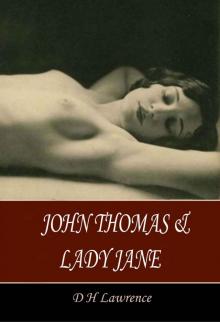 John Thomas and Lady Jane
John Thomas and Lady Jane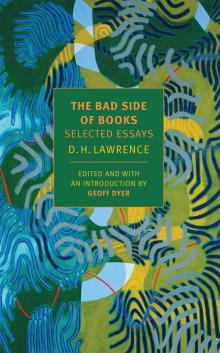 The Bad Side of Books
The Bad Side of Books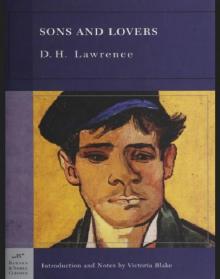 Sons and Lovers (Barnes & Noble Classics Series)
Sons and Lovers (Barnes & Noble Classics Series)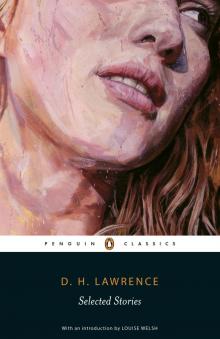 Selected Stories
Selected Stories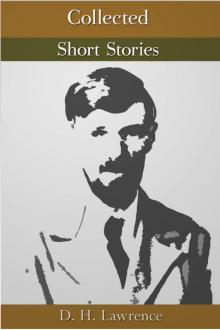 Collected Short Stories
Collected Short Stories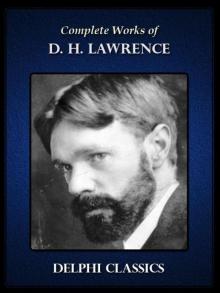 Complete Works of D.H. Lawrence (Illustrated)
Complete Works of D.H. Lawrence (Illustrated)